Michael Brown
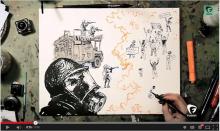
As the nation continues to wait for the grand jury’s decision whether or not to indict Darren Wilson for the killing of Mike Brown, one artist has connected the violent police acts in Ferguson to a broader narrative of state-sanctioned violence.
Molly Crabapple, known for her artistic contributions to Occupy Wall Street, combines the fast-paced style of dry-erase animation with colorful watercolor illustrations in her new video, ‘How Ferguson showed us the truth about police.’
WATCH:

What do you see when you look at this picture?
In essence, that is the question St. Louis Prosecuting Attorney Robert McCulloch asked the grand jury to determine in his case against Officer Darren Wilson, who shot and killed unarmed 18-year-old Michael Brown on Aug. 9 in Ferguson, Mo.
According to an early report in TIME, McCulloch made an unusual move: He did not specify a specific charge for Wilson.
In a recent phone interview, Denise Lieberman, co-chair of the Don’t Shoot Coalition and senior attorney for the Advancement Project, explained to me: “Grand jury proceedings occur in private, so we don’t know exactly what’s been said … However, we’ve been told that the prosecutor is not making a recommendation to the jury about whether to indict and what charges … That is fairly unusual, if in fact that is true.”
Rather than specifying charges, two senior attorneys in his office are presenting all the evidence as it becomes available and letting the grand jury decide what charge(s), if any, that evidence warrants. McCulloch’s office claimed this process is fair because the grand jury, which is representative of the community of St. Louis, is able to see all of the evidence and then offer its decision.
According to Ed Magee, a spokesperson from McCulloch’s office, grand juries usually only review a few pieces of evidence. “Normally they hear from a detective or a main witness or two. That’s it,” Magee said in an early September interview with the Washington Post.
By presenting all the evidence to laypeople, reportedly without legal interpretation, McCulloch is basically raising a proverbial Rorschach to the grand jury and saying, “see what you see.” That is not a passive act in a society where 75 percent of people tested display some measure of unconscious racial bias.
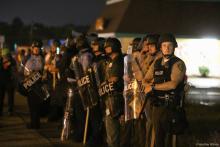
An imminent grand jury verdict in St. Louis County will determine whether to indict Ferguson police office Darren Wilson on criminal charges for shooting Michael Brown. News reports have detailed the expectation of violence in the St. Louis area after the decision is handed down and the mobilization being planned by law enforcement in response. This is an open letter to Missouri Gov. Jay Nixon urging him to maintain peace and protect those exercising their right to free speech. I encourage you to read the letter and join me and others across the country in signing it now. Your voice can make a difference. Sojourners will send the letter and signatures to the Gov. Nixon. – Jim Wallis, Sojourners
Dear Gov. Nixon,
For the last several months, the nation’s eyes have been on Ferguson, Mo. Few had heard of this small St. Louis suburb until Michael Brown was shot and killed by a member of the city’s police department — whose mission is supposedly to serve and protect. Now this community is an infamous global symbol of the nation’s continued struggle for racial equality and the troubling trend of police militarization.
Jesus proclaimed, “Blessed are the peacemakers for they shall be called the children of God” (Matthew 5:9). The Rev. Dr. Martin Luther King Jr. reminded us, “True peace is not merely the absence of tension: it is the presence of justice.” These are not idealistic thoughts or nice sentiments to be dismissed when tensions and conflict arise. Rather, they are wise words of truth that should guide our thinking in moments of distress. We need to make Jesus’ instruction real and consider Dr. King’s words a practical exhortation for the ensuring peace and public safety in Ferguson once the grand jury has made the decision of whether to indict Darren Wilson.
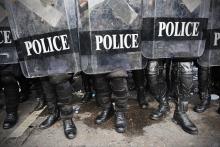
AS A FORMER reserve police officer who has taught ethics at two police academies, I followed the news very closely after 18-year-old Michael Brown was shot to death by police officer Darren Wilson in nearby Ferguson, Mo. When I saw the military equipment of the St. Louis County Police—especially the sharpshooter on top of an armored vehicle aiming his rifle at the protesters—I said to my wife, “This may turn out to be very, very bad.”
Sen. Claire McCaskill argued in the midst of the protests that St. Louis County should “demilitarize the police response” in Ferguson, telling reporters, “The police response has been part of the problem.”
The militarization of police has been trending over the past few decades. When the thin blue line resembles an occupying force, it exacerbates racial tensions in neighborhoods and communities, making things worse for everyone, including the police.
Some communities are starting to push back. For instance, the city council of Davis, Calif., recently directed its police department to get rid of a mine-resistant, ambush-protected vehicle (worth $700,000) that it had received free from the U.S. military’s surplus program.

WHEN JOHANNES BRAHMS first played his German Requiem in Vienna in 1867, the audience was shocked. In fact, scholars report that some “hissed and booed and behaved quite boorishly.”
This October, when the St. Louis Symphony performed the same piece along with German composer Detlev Glanert’s arrangement of Brahms’ Four Preludes and Serious Songs, it elicited a similar response.
Not to the work itself, but to what occurred during intermission.
As conductor Markus Stenz took the stage, two audience members began to sing. In strong, clear voices, they performed Florence Patton Reece’s famous justice hymn: “Which side are you on, friend? Which side are you on?” Nearly a dozen more scattered throughout Powell Hall joined in. While the audience watched in stunned silence, a banner unfurled from the balcony with a silhouette of a man’s face. It said: Requiem for Mike Brown 1996-2014.
As in Vienna, there were some boos from the audience and a few expletives—more disruption following the Aug. 9 shooting death of Michael Brown, an unarmed African-American teenager, by white police officer Darren Wilson. While the Vienna audience complained that Brahms’ music was too religious for a secular setting, one St. Louis symphony-goer asked, “Is Powell Hall a proper venue for a protest?” And a Catholic priest challenged: “Instead of chanting ‘Which side are you on?’ further dividing the community, try singing ‘How can we heal?’”
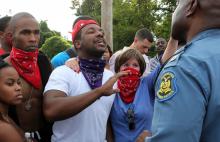
The first time the public heard the name Renita Lamkin was probably the day she was shot.
In early August, four days after Michael Brown was killed by Officer Darren Wilson, Lamkin, a pastor, stood with Ferguson protesters, attempting to mediate. Police had warned the crowd to disperse and in an effort to buy a little time, Lamkin shouted, “They’re leaving!”
“That’s when I felt a pop in the stomach,” Lamkin said of the rubber pellet that hit her. The pellet left a ghastly wound — large, deep and purplish — and created a social media frenzy.
Tweet after tweet showed Lamkin, 44 and white, wearing a T-shirt with an image of a cross that she lifted up just slightly to show off the ugly bruise.
Lamkin said she didn’t really have a plan when she ventured out to Ferguson but that “the whole being shot thing was probably the best thing that could have happened.” The injury had cemented Lamkin’s role in the struggle for racial equality.
“They say, ‘You took a bullet for us.’ My sense is …We’re in this together, and I was playing my role,” Lamkin said.

One of the greatest sermons I ever heard on the subject of communion was offered by the head pastor of a Christian Missionary Alliance church in Princeton, N.J., back in the late 1980s. This pastor spent most of that sermon talking about the cross and how Jesus’ body was literally broken. I can still hear the crunch of the nails going into Jesus’ wrists that I heard in my mind’s ear that Sunday. And this wasn’t Easter week. It was just a communion Sunday.
Toward the end of his sermon, the pastor brought out a piece of saltine cracker that lay in the communion plate. He cracked it and then he said this: “Every time I take communion I hear the crack of the bread in my mouth and I bite and remember the crack of Jesus’ bones … and I remember that I did that.”
I wept as we took communion that day.
But isn’t that really about dis-union — the dis-union of Christ’s actual physical body? The cracking of his bones, the breaking of his legs, the piercing of his flesh; the cross seems to be more about a breaking apart than a bringing together of Christ’s body.
Right now when I see the lived reality of the church in our world, it seems we are more in a state of dis-union than communion.
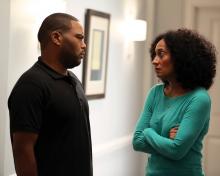
Black-ish, the new ABC sitcom created by Kenya Barris, really is one of the funniest shows on TV this season. I laughed my head off watching a marathon run of the first four episodes On Demand. Now it's set to record each week on DVR. One of the things I really appreciate about Black-ish is that it takes universal issues and works them out through a genuinely African-American lens.
For example, in the pilot episode the father, Andre “Dre” Johnson, played by Anthony Anderson, is looking forward to a much deserved promotion to Senior VP at a major marketing firm. He is surprised to find out he’s been promoted to Senior VP of the Urban Division. We can all relate to wanting the promotion, but Anderson’s challenge is one particularly familiar within the black professional class. How do you jump the dreaded, yet anticipated, pigeonholing of your value and worth to an organization as a “black” person? How do you become just Senior VP — not SVP of the “Urban” Division? How do you become human? The way Anderson works out this challenge is hilarious. I rolled with laughter even after the half-hour sitcom had reached its conclusion.
And then there’s last week’s episode when the biracial mother, Rainbow, masterfully played by Tracee Ellis Ross, loses her young son, Jack, while shopping at a department store. It turns out Jack is hiding inside a clothes rack and is eventually found by a sympathetic officer. We can all relate to this situation. Children hide in department stores. I did the exact same thing to my own mother when I was about Jack’s age. I hid between the racks at a Marshalls. But Rainbow and Dre’s conundrum rears its head when they are confronted with the question: Will they spank their son? It seems simple enough, but it’s not. This is not only a question of parenting, it is also a question of tradition and culture.
In fact, each episode presents a universal situation that pushes a particular issue of culture within the African-American community. Ultimately, the situation presses the question: “What does it means to be black?”

Michael Brown. Sandy Hook. Trayvon Martin. Aurora. Columbine.
Within the last decade, the narrative of children and teenagers being killed by gun violence has become an all-too-familiar narrative in the American public sphere. In a recent report compiled by The Brady Campaign, statistics revealed that in 2011 alone, 19,403 children were shot and 2,703 children and teenagers lost their lives to guns.
That’s seven of America’s youth under the age of 20 killed every day.
In the book of Matthew, the disciples ask Jesus, “Who is the greatest in the kingdom of heaven?”
Jesus calls a child to join the group.
“Truly I tell you, unless you change and become like children, you will never enter the kingdom of heaven,” he answers.
If as Christians, children represent God’s creation in its most pure and innocent form, why is it that as Americans, we continue to let children die preventable deaths from gun violence? Gun control policies are a difficult discourse for the American public. Yet one thing we can all agree on is that children should not be killed.
Of the 2,703 children killed in 2011, 61 percent were homicides, 32 percent were suicides and 5 percent were unintentional shooting. These statistics propel gun-related deaths to the number two leading cause of death for youth in America.
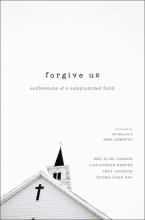
I attended Catholic school for one year as a child. My second-grade year in Philadelphia’s St. Athanasius left me with a strong sense of the mystery of the church. The most mysterious space there was the confessional booth. I wasn’t allowed to enter because I wasn’t Catholic, so I just sat and watched others enter with pinched brows. Then they would exit with peace painted over their faces.
There is a scene in the book Blue Like Jazz where author Donald Miller sets up a confessional box in the center of the Reed College campus. But Miller’s confessional worked in reverse. Students of Reed, which is known as the most liberal campus in the country, entered the confessional booth with curiosity, cynicism, skepticism, or worse — to disprove this thing called Christianity. But what they encountered upon entry was disarming — even healing. Rather than prompts to confess their sin, Miller sat on the other side of the veil and confessed of the sins of the church. This was a revolutionary act in the context where, according to Gabe Lyons and David Kinnaman’s modern classic, UnChristian, the general consensus about Christians is decidedly negative.
Ryan Herring reads Langston Hughes' "Harlem" as photos of Ferguson are displayed.
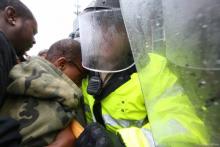
“Get the word out. Teach all these things. And don’t let anyone put you down because you’re young. Teach believers with your life: by word, by demeanor, by love, by faith, by integrity.” –1 Timothy 4:12 (The Message)
In our recent book Forgive Us: Confessions of a Compromised Faith, Mae Cannon, Lisa Sharon Harper, Soong-Chan Rah, and I call the American church to a posture of repentance due to all the times we have not only been on the wrong side of history, but on the wrong side of God.
As an organizer and director of the AMOS Project in Cincinnati, I’ve discovered that a humble spirit of repentance is critical to powerful work around racial and economic justice. There can be a strong temptation to replay colonialism by having all the answers and believing we are God’s gift to the oppressed. We white evangelicals are particularly susceptible to this arrogant path. Humility and a repentant spirit are key to a healthy engagement and partnership in our work.
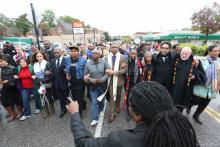
Thousands of people from around the country came to Ferguson, Mo., for a “weekend of resistance.” But for faith leaders it was a weekend of repentance. Twenty of us were arrested in Ferguson yesterday for an act of repentance.
I went to Ferguson as a faith leader but, in particular, as a white faith leader. Because the great disparity between how differently young black lives are treated in our criminal justice system than young white lives is a fundamental injustice that must not only be left to black faith leaders to raise up. Repentance must begin in the white Christian community for tolerating this offense to our black brothers and sisters and, ultimately, this offense to God. Let me be as honest as I can be. If white Christians in America were more Christian than white, black parents could feel safer about their children. It’s time for us white Christians to repent — turn around and go in a new direction.
Repentance is a powerful theme throughout the Bible. But its meaning is often not well understood. Repentance is not about being sorry or just feeling guilty. It is about turning in a new direction. The biblical word for repentance in the original Greek is metanoia, which means you are going in the wrong direction, and it’s time to turn right around.
In the case of Ferguson, repentance means more than merely acknowledging the tragic death of an unarmed 18-year-old African-African man named Michael Brown on Aug. 9 — shot and killed by a white police officer named Darren Wilson. Repentance means more than lamenting the loss of another young black man or being sympathetic to his grieving mother. True repentance means changing the direction of the practices and policies that led to his death and so many others.
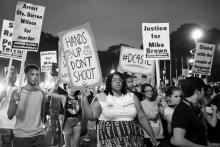
ON AUG. 9, Michael Brown, an unarmed black teenager, was shot to death by Ferguson, Mo., police officer Darren Wilson. A collective groan was let out across social networks—people began the lament “Not again.”
Just four days prior, John Crawford III, a 21-year-old black man, had been gunned down by police in a Walmart in suburban Dayton, Ohio, without warning, while shopping for a BB gun. A few weeks earlier, Eric Garner, an African-American man, was choked to death by a New York City police officer.
For young black men, each incident is a reminder of how easily our lives can be taken away by police aggression. For the people in Ferguson, however, over-policing is all too familiar. In a city where 67 percent of the residents are black, there are only three black police officers on a force of 53.
A 2013 report from the Missouri attorney general’s office revealed just how bad relations are between officers and black citizens. Out of the 5,384 traffic stops made last year by the Ferguson Police Department, 86 percent of them targeted black drivers. Black drivers were searched and arrested at nearly twice the rate of white drivers, although contraband was found at a rate 13 percent less than that of white drivers.
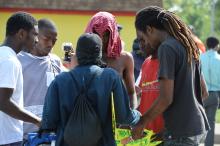
If, as many of the religions of the world affirm, there is a profound equality of dignity and worth between all human beings by virtue of their humanity alone, then what are we to make of a nation and its citizens who allow an entire group of people, a people once brutally enslaved and still actively oppressed, to continue to be stigmatized in ways that implicitly affirm their inferiority as a group and so allow too many of them to experience the devastating consequences of entrenched racial inequality? That nation and its citizens would stand accused of the greatest of injustices. That nation and its citizens would have a divine duty to end that injustice. The United States and we its citizens stand so accused today. Until we understand the imperative to eliminate racial inequality as an obligation grounded in ultimate reality, we will fail to understand the magnitude of our responsibility.
Whether the issue is wealth, health, incarceration, employment, or education, blacks as a group experience significantly disproportionate negative outcomes compared to whites. What accounts for this difference? Only two options are available. Significant racial inequality over time is explained either by forces external to the lives of black individuals (e.g., economic, legal, and social forces), or by the aggregate consequences of choices made by these individuals. Unless one concludes that racial inequality is entirely explained by forces external to the lives of black people, one is forced to conclude that there is something inferior about blacks as a group that causes them persistently to make more bad life choices than whites as a group.
At this point, some will object that some black people do indeed make bad choices that lead to bad outcomes. But so do some white people. The question is what accounts for the differences in the proportion of bad outcomes?
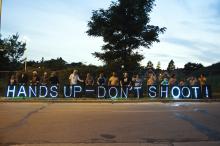
Dr. King said: a “riot is the language of the unheard.”
What happens when folks do not feel like their voices are being heard?
They shout louder.
Rioting is what almost happened in Ferguson, and all of us who live in fragile neighborhoods with a backdrop of deep racial injustice need to pay attention.
In Ferguson, a close-knit community was devastated by yet another injustice. They wanted to be heard. But as peaceful marches began, they were met with unprecedented force.
Tears were met with teargas.
It was as if authorities were putting their hands up over their ears. So the people shouted louder – and the world began to pay attention.
At a fragile moment when emotions were running high, the people of Ferguson had to choose between rioting and nonviolent direct action in the streets. A very small group (many of them arguably out-of-state activists) resorted to some forms of property damage. And it caught the media’s attention.
Some might say it hijacked the headlines.
But that is not how I will remember Ferguson.

I walked across the school yard and through the ominous painted doors of St. Athanasius Elementary School for the first time. My mother and I had walked hand in hand the long city block from home to the school, across the school yard, through the entrance, down the hallway, heels now echoing against linoleum and lockers as the smell of chalk and mimeographed copies wafted from each classroom we passed.
We entered my second-grade classroom where I was greeted by the teacher who told me to take my seat four heads from the front. That seat was my second home for half of every day for a year.
I had high hopes for second grade. At the very least, I hoped it would be safe. It wasn’t.
The girl who sat behind me demanded 25 cents per day to be my friend — or else. But worse, the white woman charged with teaching our classroom full of African-American children ruled us as if we were in her military camp … or worse… prison.
My teacher once punched me in the back because I forgot to hand in an assignment — in second grade.
Now take that single act of aggression and magnify it: a punch in the back becomes a suspension, an expulsion, or an arrest. Then systematize it. Call it a “Zero Tolerance” policy and spread it across 90 percent of schools in the United States. Then apply the policy inequitably, such that African-American children are punished at higher rates and more severely than white children. That is what happened when the culture of severe punishment promoted by the Tough on Crime movement permeated education systems throughout the 1990s.
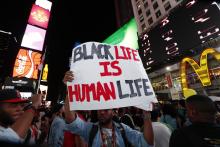
One month ago, the city of Ferguson, Mo., was violently shaken by the shooting death of an unarmed black man whose name is Michael Brown, Jr.
This is not the first time we’ve stood in this place. Michael Brown has been added to the roll call of unarmed black people killed by those hired to protect and to serve. His name joins the names of:
John Crawford , an unarmed Ohio man gunned down inside of a Walmart while examining a toy gun sold in the store.
Eric Garner , an unarmed New York man killed, after stating several times that he was having difficulty breathing, by an officer using an illegal choke hold.
Sean Bell , an unarmed New York man shot multiple times outside of the venue for his bachelor party the night before his wedding.
Oscar Grant , an unarmed Oakland man who was handcuffed, face down, before he was fatally shot.
And so many more black lives, both male and female, ended by the reflexes of a legal system designed to police some and protect others.
So why did the killing of Michael Brown, Jr. ignite such a firestorm of rage in a region and a nation where slain black bodies are commonplace?
This is not one of those neighborhoods that cause political analysts to pontificate over “how something so tragic could happen here.”
These are not deaths that leave communities and congregations struggling to find deeper meaning and psychological factors that might have contributed to the tragic loss of life.
As a matter of fact, since the death of Michael Brown, there have been two killings of black men with documented mental challenges, Ezell Ford of Los Angeles and Kajieme Powell, killed only a few miles from the site of Michael Brown’s death. Yet there have been no roundtable discussions of the role of mental illness in our society sparked by these deaths.
What made Michael Brown’s death different?